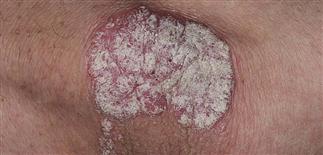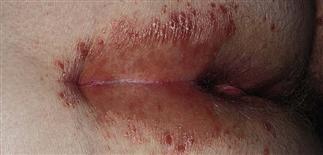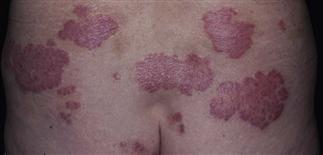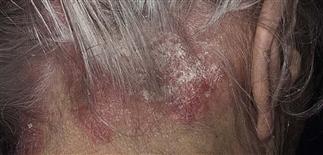37
Psoriasis: lesions

The primary lesion is a red, scaling, defined papule with varying amounts of silvery scale.

Intertriginous plaques, here in the gluteal cleft, are often thin with minimal moist surface scale.

Thick inflamed plaques on the lower back with thin scale and excoriation. Occipital scalp plaques often have thick scale and well-defined borders.

Lesions may first appear on the knees, elbows, and scalp. In contrast to eczema, thick psoriatic plaques have a sharply defined border. Thick scale with thin underlying inflammation respond to topical keratolytic followed by topical steroid.
DESCRIPTION
Chronic, inflammatory disease due to abnormal T-lymphocyte function. Affects skin, scalp, joints, nails.
HISTORY
• Prevalence: 1–3%. • Men, women affected equally. • Onset: any age, peaks late twenties, early fifties. • Chronic. • Genetic predisposition. • Triggers: stress, trauma, infections, drugs. • Psychosocial impact severe.
PHYSICAL FINDINGS
• Usually pink to red, sharply defined, scaling papules coalesce, forming plaques. Elbows, knees, scalp most common. Scale adherent, silvery. Pinpoint bleeding when scale removed. • Presentations: guttate, pustular, erythrodermic, inverse.
TREATMENT
Topical (chronic plaques)
• Topical steroids. Groups I–V. Fast, temporary relief. Side effects: atrophy, telangiectasia. • Calcipotriol/Calcipotriene. (Dovonex cream, Vectical) ointment, 100 g, b.i.d. on weekdays as tolerated. Group I or II topical steroids b.i.d., weekends. • Taclonex ointment is a combination calcipotriene, class II steroid for once daily use • Tazarotene. Tazorac 0.05%, 0.1%, cream (15, 30, 100 g) or gel (30, 100 g), q.h.s. Less frequently if irritation. Group I–IV topical steroids q. morning for irritation. • Tar preparations (over-the-counter). Low cost, effective. Limited by odor, irritation, clothing stains. • Phototherapy: narrowband ultraviolet B (NB-UVB). Dermatologists administer 2–5 times per week. • Psoralen plus ultraviolet A (PUVA). Dermatologists administer 3 times per week until clear, then tapered. Patient takes oral psoralen 1.5–2 h before exposure. Very effective. Side effects: gastrointestinal intolerance, sunburn, skin aging, skin cancer risk.
Systemic
Dermatologist-supervised. Combining topical, systemic helps limit toxicity, enhance efficacy. • Methotrexate. Given orally, average 7.5–15 mg/week. Adjust dose to maintain control. Folic acid 1 mg q.d. (but not methotrexate days). Monitor complete blood count (CBC), liver function tests (LFT); periodic liver biopsy. Serious drug interactions possible. Side effects: nausea, anorexia, fatigue, oral ulcerations, mild leukopenia, thrombocytopenia, hepatotoxicity. • Ciclosporin (Neoral). Rapid, temporary control (severe psoriasis). Dosage 2.5–5.0 mg/kg q.d. Monitor blood pressure, CBC, creatinine, magnesium, cholesterol, triglycerides. Many drug interactions. Side effects: hypertension, nephrotoxicity. • Acitretin (Soriatane). May combine with PUVA, UVB. Orally, 10–50 mg q.d. Monitor triglycerides, cholesterol, CBC, LFT, blood urea nitrogen, creatinine. Side effects: teratogenicity, dry skin, myalgias, arthralgias, pseudotumor cerebri, alopecia, increased triglycerides. • Biologic immunomodulatory therapy. Engineered human proteins target T-cell-mediated inflammatory processes. Etanercept (Enbrel) binds tumor necrosis factor-α. Patient-administered, 50 mg s.c. once weekly. Adalimumab (Humira) similarly binds TNF-α. Patient-administered, 50 mg s.c. every other week. Infliximab (Remicade), also a TNF-α inhibitor is given intravenously every 8 weeks. All three TNF-α inhibitors are approved for psoriatic arthritis. Ustekinumab (Stelara) binds IL-12 and IL-23 thus interfering with T-cell function in psoriasis. In-office dosing is every 12 weeks.







